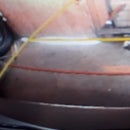Introduction: Hydration Reservoir Port - Hiking Pack
There was only one problem with my super awesome canvas 20 year old hiking pack when i discovered hydration reservoir
... it was made before the hose ports became normal.... This pack was made so well that when i went in for a new harness, they gave it to me for free.. to keep that pack label on the track:-)
So instead i set about upgrading it to the now... - this works for a heavy fabric pack - not sure how it would go with the lighter materials in modern packs - but then they should have a port already....
I used;
- 120mm x 60 x3.5mm piece of leather
- Short length of webbing (sourced from that wrecked car dumped over the bank lol)
- 1000mm x 15mm length of webbing
- Speedy stitcher ( one of the most useful tools i ever got)
- Speedy stitcher - waxed thread
- 8lt Dry bag
- Sharp pair of scissors and or sharp pocket knife
- Marker Pen
- Roll of Duct tape
- Couple of Spring clamps
- Hydration reservoir and extension hose ( i just love the Camel Bak Antidote- and their snap fittings that on top of a bullet proof bladder make it a synch to make and extension hose)
Step 1: Make the Reservoir Hose Port
- Cut the piece of leather in halve to create two 60mm x 60mm squares.
- Laying the leather flat with the smooth side up, from the center of each piece of leather draw the four arms of a +. Each 20mm long.(Image 1)
- Using the Scissors (or pocket knife), start at the center and cut out along each line.
- Locate the position for the pipe hole - i made my exit just above the level of where the shoulder harness joins the pack and just below the level of the top draw string closure.
- Place a 60mm x 40mm square (minimum) of Duct tape over the proposed hole position on the outside.
- Using the scissors, cut out a 20mm square of the outside of the pack in that position, and then center the second piece of tape over the hole, and cut out the center to match the pack hole.
- Then center the one leather patch over the outside of the hole.
- Take the other patch and rotate it 45 degrees to the position of the cut on the outer patch. (Image 2.)
- Pop a spring clamp in from the top to hold both in place.
- Stitch both patches onto the pack. (over the duct tape)
Step 2: Make the Reservoir Support
- I cut about 100mm of the thick webbing and formed a loop taping each flat end together.
- Using the spring clamp, i attached the taped ends of the loop to the inside top center of the pack.(along the top edge of the inner pack)
- Then stitched this in place. (Image 3.)
- Popped a spare small carabiner through the loop.
Step 3: Fitting the Hydration Reservoir
Keeping the heavy items low and central makes is how i like to keep my pack nicely balanced, so i always have my hydration pack hanging at the bottom center against the back, behind my sleeping night gear.
While i have never had a Camel bak rupture i always hang the reservoir bag inside a dry bag, as there is always a little bit of condensation to collect. ( and this dose also make a useful emergency bladder bag)
- To achieve this i install my extension tube between the bladder and my standard hose.
- Lower the full reservoir bag into the dry bag and close the snap clips.
- Fold the 1000mm length of the webbing in halve and pass the loop though the Camel Bak hook, and then through the D ring attached to the dry bag clips (Image 4.) and take the ends up to the Carabiner on the top fixed loop. (Image 5.)
- I suspend the bag so the bottom just touches the bottom of the pack, and then tie off the ends of the loops to the Carabiner on the loop installed at the top of the pack.
- Refilling is a simple as pulling the dry bag out, un hooking it from the loop and un clicking the hose

Participated in the
Outside Contest 2017

Participated in the
Fix It Contest













